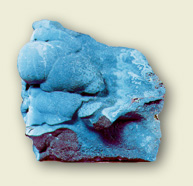How Azurite is made:
| Origin: mineral and artificial | Natural mineral (at Mineralogy Database) found in many parts of the world in the upper oxidized portions of copper ore deposits, often near malachite, the green basic carbonate of copper. |
   Azurite |
|
| Natural variety of pigment | Mineral azurite is simply ground, washed, and sieved. Coarsely ground azurite produces a dark blue, while finely ground azurite produces a lighter tone. |
| Artificial variety of pigment | Numerous early recipes for the preparation of basic copper carbonate are knownfrom the 17th century; the best types appear to have been prepared at relatively low temperatures with a copper salt. This sky blue, slightly more greenish than natural azurite, lends itself well to consistent applications of color. Microscopically, blue bice appears as tiny, rounded, fibrous aggregates, even in size and blue by transmitted light. It is similar in color to finely ground azurite. |
| 19th century recipe | Dissolve the copper, cold, in nitric acid (aquafortis), and produce a precipitation of it by means of quicklime, employed in such doses that it will be absorbed by the acid, in order that the precipitate may be pure oxide of copper, that is, without any mixture. When the liquor has been decanted, wash the precipitate and spread it out on a piece of linen cloth to drain. If a portion of this precipitate, which is green, be placed on a grinding-stone, and if a little quicklime, in powder, be added, the green color will be immediately changed into a beautiful blue. The proportion of the lime added is from 7 to 10 parts in 100. When the whole matter acquires the consistence of paste, desiccation soon takes place. |
| In the lab | |
| Method: |
|
The ground pigment:
Pile of ground Azurite

Other blues
(intro) - Azurite - Cerulean Blue - Cobalt blue - Egyptian blue - Prussian blue - Smalt - Ultramarine
(intro) - Azurite - Cerulean Blue - Cobalt blue - Egyptian blue - Prussian blue - Smalt - Ultramarine

